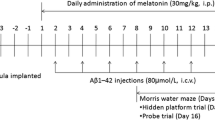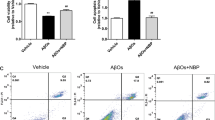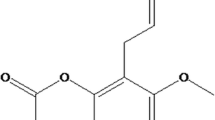Abstract
Background
Soluble Amyloid-beta (Aβ) oligomers are thought to play a key role in the pathogenesis of Alzheimer’s disease (AD), which is the most common age-associated neurodegenerative diseases with obvious neuropathological changes and functional decline in both cortical and subcortical regions. Melatonin is ubiquitously distributed and multifunctioning indoleamine. Accumulating studies support that melatonin is potential therapeutic molecule for AD through modulating a broad variety of signaling pathways. In recent years, Notch1 signaling pathway is been known involved in dynamic changes in the cellular architecture and function of adult brain, as well as associated with the pathophysiology of AD and other neurodegenerative disorders.
Methods and results
In this study, we performed real-time polymerase chain reaction, immunohistochemistry and western blotting analyses using the cerebral cortical tissues of Aβ1−42 oligomers-induced AD rats with or without melatonin treatment. Our results showed that soluble Aβ1−42 oligomers decreased the expression of the main components of Notch1 signaling pathway, Notch1, NICD and Hes1 in the cerebral cortex, and melatonin could restore the level of Notch1, NICD and Hes1.
Conclusion
This observation suggests that targeting of Notch1 signaling might be a promising therapeutic approach for AD and other age-associated neurodegenerative diseases, and melatonin might serve as a potential therapeutic agent for AD and other age-associated neurodegenerative diseases.



Similar content being viewed by others
References
Scheltens P, De Strooper B, Kivipelto M et al (2021) Alzheimer’s disease. Lancet 397:1577–1590. https://doi.org/10.1016/s0140-6736(20)32205-4
Guo T, Zhang D, Zeng Y, Huang TY, Xu H, Zhao Y (2020) Molecular and cellular mechanisms underlying the pathogenesis of Alzheimer’s disease. Mol Neurodegener 15:40. https://doi.org/10.1186/s13024-020-00391-7
Cline EN, Bicca MA, Viola KL, Klein WL (2018) The amyloid-β oligomer hypothesis: beginning of the third decade. J Alzheimers Dis 64:S567-s610. https://doi.org/10.3233/jad-179941
Kreutzer AG, Nowick JS (2018) Elucidating the structures of amyloid oligomers with macrocyclic β-Hairpin peptides: insights into Alzheimer’s Disease and other amyloid Diseases. Acc Chem Res 51:706–718. https://doi.org/10.1021/acs.accounts.7b00554
Jarrett JT, Berger EP, Lansbury PT Jr (1993) The carboxy terminus of the beta amyloid protein is critical for the seeding of amyloid formation: implications for the pathogenesis of Alzheimer’s disease. Biochemistry 32:4693–4697. https://doi.org/10.1021/bi00069a001
Gouras GK, Olsson TT, Hansson O (2015) β-Amyloid peptides and amyloid plaques in Alzheimer’s disease. Neurotherapeutics 12:3–11. https://doi.org/10.1007/s13311-014-0313-y
Bitan G, Kirkitadze MD, Lomakin A, Vollers SS, Benedek GB, Teplow DB (2003) Amyloid beta -protein (abeta) assembly: Abeta 40 and Abeta 42 oligomerize through distinct pathways. Proc Natl Acad Sci USA 100:330–335. https://doi.org/10.1073/pnas.222681699
Walsh DM, Selkoe DJ (2007) A beta oligomers—a decade of discovery. J Neurochem 101:1172–1184. https://doi.org/10.1111/j.1471-4159.2006.04426.x
Selkoe DJ, Hardy J (2016) The amyloid hypothesis of Alzheimer’s disease at 25 years. EMBO Mol Med 8:595–608. https://doi.org/10.15252/emmm.201606210
Raha S, Ghosh A, Dutta D, Patel DR, Pahan K (2021) Activation of PPARα enhances astroglial uptake and degradation of β-amyloid. Sci Signal 14:eabg4747. https://doi.org/10.1126/scisignal.abg4747
Fujita Y, Maeda T, Sato C et al (2020) Engulfment of toxic amyloid β-protein in neurons and astrocytes mediated by MEGF10. Neuroscience 443:1–7. https://doi.org/10.1016/j.neuroscience.2020.07.016
Wang P, Sui HJ, Li XJ, Bai LN, Bi J, Lai H (2021) Melatonin ameliorates microvessel abnormalities in the cerebral cortex and hippocampus in a rat model of Alzheimer’s disease. Neural Regen Res 16:757–764. https://doi.org/10.4103/1673-5374.295349
Zhang S, Wang P, Ren L, Hu C, Bi J (2016) Protective effect of melatonin on soluble Aβ1-42-induced memory impairment, astrogliosis, and synaptic dysfunction via the Musashi1/Notch1/Hes1 signaling pathway in the rat hippocampus. Alzheimers Res Ther 8:40. https://doi.org/10.1186/s13195-016-0206-x
Schützmann MP, Hasecke F, Bachmann S et al (2021) Endo-lysosomal Aβ concentration and pH trigger formation of Aβ oligomers that potently induce tau missorting. Nat Commun 12:4634. https://doi.org/10.1038/s41467-021-24900-4
Brouillette J, Caillierez R, Zommer N et al (2012) Neurotoxicity and memory deficits induced by soluble low-molecular-weight amyloid-β1–42 oligomers are revealed in vivo by using a novel animal model. J Neurosci 32:7852–7861. https://doi.org/10.1523/jneurosci.5901-11.2012
DeTure MA, Dickson DW (2019) The neuropathological diagnosis of Alzheimer’s disease. Mol Neurodegener 14:32. https://doi.org/10.1186/s13024-019-0333-5
Wu BS, Zhang YR, Li HQ et al (2021) Cortical structure and the risk for Alzheimer’s disease: a bidirectional mendelian randomization study. Transl Psychiatry 11:476. https://doi.org/10.1038/s41398-021-01599-x
Torso M, Ahmed S, Butler C, Zamboni G, Jenkinson M, Chance S (2021) Cortical diffusivity investigation in posterior cortical atrophy and typical Alzheimer’s disease. J Neurol 268:227–239. https://doi.org/10.1007/s00415-020-10109-w
Fracassi A, Marcatti M, Zolochevska O et al (2021) Oxidative damage and antioxidant response in Frontal Cortex of demented and nondemented individuals with Alzheimer’s Neuropathology. J Neurosci 41:538–554. https://doi.org/10.1523/jneurosci.0295-20.2020
Slominski RM, Reiter RJ, Schlabritz-Loutsevitch N, Ostrom RS, Slominski AT (2012) Melatonin membrane receptors in peripheral tissues: distribution and functions. Mol Cell Endocrinol 351:152–166. https://doi.org/10.1016/j.mce.2012.01.004
Varoni EM, Soru C, Pluchino R, Intra C, Iriti M (2016) The impact of melatonin in research. Molecules. https://doi.org/10.3390/molecules21020240
Esposito S, Laino D, D’Alonzo R et al (2019) Pediatric sleep disturbances and treatment with melatonin. J Transl Med 17:77. https://doi.org/10.1186/s12967-019-1835-1
Li Y, Zhang J, Wan J, Liu A, Sun J (2020) Melatonin regulates Aβ production/clearance balance and Aβ neurotoxicity: a potential therapeutic molecule for Alzheimer’s disease. Biomed Pharmacother 132:110887. https://doi.org/10.1016/j.biopha.2020.110887
Ansari Dezfouli M, Zahmatkesh M, Farahmandfar M, Khodagholi F (2019) Melatonin protective effect against amyloid β-induced neurotoxicity mediated by mitochondrial biogenesis; involvement of hippocampal Sirtuin-1 signaling pathway. Physiol Behav 204:65–75. https://doi.org/10.1016/j.physbeh.2019.02.016
Hu C, Wang P, Zhang S et al (2017) Neuroprotective effect of melatonin on soluble Aβ(1–42)-induced cortical neurodegeneration via Reelin-Dab1 signaling pathway. Neurol Res 39:621–631. https://doi.org/10.1080/01616412.2017.1312805
Gong YH, Hua N, Zang X, Huang T, He L (2018) Melatonin ameliorates Aβ(1–42) -induced Alzheimer’s cognitive deficits in mouse model. J Pharm Pharmacol 70:70–80. https://doi.org/10.1111/jphp.12830
Li J, Gordon J, Chen ELY et al (2020) NOTCH1 signaling establishes the medullary thymic epithelial cell progenitor pool during mouse fetal development. Development. https://doi.org/10.1242/dev.178988
Nian FS, Hou PS (2022) Evolving roles of Notch signaling in cortical development. Front Neurosci 16:844410. https://doi.org/10.3389/fnins.2022.844410
Ables JL, Breunig JJ, Eisch AJ, Rakic P (2011) Not(ch) just development: notch signalling in the adult brain. Nat Rev Neurosci 12:269–283. https://doi.org/10.1038/nrn3024
Cho SJ, Yun SM, Jo C et al (2019) Altered expression of Notch1 in Alzheimer’s disease. PLoS ONE 14:e0224941. https://doi.org/10.1371/journal.pone.0224941
Tolar M, Abushakra S, Sabbagh M (2020) The path forward in Alzheimer’s disease therapeutics: reevaluating the amyloid cascade hypothesis. Alzheimers Dement 16:1553–1560. https://doi.org/10.1016/j.jalz.2019.09.075
Viola KL, Klein WL (2015) Amyloid β oligomers in Alzheimer’s disease pathogenesis, treatment, and diagnosis. Acta Neuropathol 129:183–206. https://doi.org/10.1007/s00401-015-1386-3
Hampel H, Hardy J, Blennow K et al (2021) The Amyloid-β pathway in Alzheimer’s Disease. Mol Psychiatry 26:5481–5503. https://doi.org/10.1038/s41380-021-01249-0
Romito-DiGiacomo RR, Menegay H, Cicero SA, Herrup K (2007) Effects of Alzheimer’s disease on different cortical layers: the role of intrinsic differences in Abeta susceptibility. J Neurosci 27:8496–8504. https://doi.org/10.1523/jneurosci.1008-07.2007
Kimura R, Ohno M (2009) Impairments in remote memory stabilization precede hippocampal synaptic and cognitive failures in 5XFAD Alzheimer mouse model. Neurobiol Dis 33:229–235. https://doi.org/10.1016/j.nbd.2008.10.006
Fjell AM, McEvoy L, Holland D, Dale AM, Walhovd KB (2014) What is normal in normal aging? Effects of aging, amyloid and Alzheimer’s disease on the cerebral cortex and the hippocampus. Prog Neurobiol 117:20–40. https://doi.org/10.1016/j.pneurobio.2014.02.004
Hashimoto-Torii K, Torii M, Sarkisian MR et al (2008) Interaction between Reelin and Notch signaling regulates neuronal migration in the cerebral cortex. Neuron 60:273–284. https://doi.org/10.1016/j.neuron.2008.09.026
Brai E, Marathe S, Astori S et al (2015) Notch1 regulates hippocampal plasticity through Interaction with the Reelin pathway, glutamatergic transmission and CREB signaling. Front Cell Neurosci 9:447. https://doi.org/10.3389/fncel.2015.00447
Salazar JL, Yang SA, Yamamoto S (2020) Post-developmental roles of Notch Signaling in the nervous system. Biomolecules. https://doi.org/10.3390/biom10070985
Ribeiro TN, Delgado-García LM, Porcionatto MA (2021) Notch1 and Galectin-3 modulate cortical reactive astrocyte response after Brain Injury. Front Cell Dev Biol 9:649854. https://doi.org/10.3389/fcell.2021.649854
Sumsuzzman DM, Choi J, Jin Y, Hong Y (2021) Neurocognitive effects of melatonin treatment in healthy adults and individuals with Alzheimer’s disease and insomnia: a systematic review and meta-analysis of randomized controlled trials. Neurosci Biobehav Rev 127:459–473. https://doi.org/10.1016/j.neubiorev.2021.04.034
Shukla M, Govitrapong P, Boontem P, Reiter RJ, Satayavivad J (2017) Mechanisms of melatonin in alleviating Alzheimer’s Disease. Curr Neuropharmacol 15:1010–1031. https://doi.org/10.2174/1570159x15666170313123454
Zhang LL, Sui HJ, Liang B et al (2014) Atorvastatin prevents amyloid-β peptide oligomer-induced synaptotoxicity and memory dysfunction in rats through a p38 MAPK-dependent pathway. Acta Pharmacol Sin 35:716–726. https://doi.org/10.1038/aps.2013.203
Funding
This study was supported by the Grants from Climbing Scholars Support Plan of Liaoning Province (2012 to JB), Innovation Team Support Program of Universities in Liaoning Province (No. LT2017018 to JB) and the Principal’s Fund Liaoning Medical University (No. 201310160002 to Pan Wang).
Author information
Authors and Affiliations
Contributions
PW contributed to concept/design, acquisition of data, data analysis/interpretation, and drafting of the manuscript. SZ, LLR and CH contributed to acquisition of data and data analysis/interpretation. JB contributed to concept/design, data analysis/interpretation, critical revision of the manuscript, and approval of the article. All authors read and approved the final manuscript.
Corresponding author
Ethics declarations
Conflict of interest
The authors declare that they have no conflict interest.
Ethical approval
All experimental procedures were performed in accordance with the guidelines of the Animal Care and Use Committee of Jinzhou Medical University and approved by the Animal Ethics Committee of Jinzhou Medical University.
Additional information
Publisher’s Note
Springer Nature remains neutral with regard to jurisdictional claims in published maps and institutional affiliations.
Rights and permissions
Springer Nature or its licensor (e.g. a society or other partner) holds exclusive rights to this article under a publishing agreement with the author(s) or other rightsholder(s); author self-archiving of the accepted manuscript version of this article is solely governed by the terms of such publishing agreement and applicable law.
About this article
Cite this article
Wang, P., Zhang, S., Hu, C. et al. Regulatory role of melatonin in Notch1 signaling pathway in cerebral cortex of Aβ1−42-induced Alzheimer’s disease rat model. Mol Biol Rep 50, 2463–2469 (2023). https://doi.org/10.1007/s11033-022-08213-3
Received:
Accepted:
Published:
Issue Date:
DOI: https://doi.org/10.1007/s11033-022-08213-3




